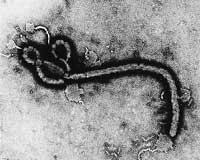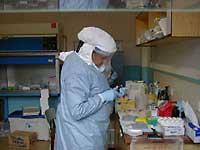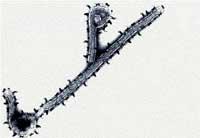New Ebola detection test
2002/02/27 Mendiburu, Joana - Elhuyar Zientziaren Komunikazioa

The Ebola virus was first discovered in Africa in 1976. That year, a deadly epidemic broke out in the Democratic Republic of Congo and Sudan. After several years of silence, since 1994 the virus has reappeared in several African countries; in 1994 in Ivory Kosta, in 1995 in the Democratic Republic of the Congo, in Uganda in 1999 and in Christmas in 1994, 1995 and 1996.
Ebola hemorrhagic fever
Ebola is a very contagious filobirus for primates and, above all, for men. In the most severe cases, mortality can reach 88%. It is often contagious because man is in contact with the contaminated monkey, but they still do not know how it is contaminated. The transmission of man to man is done through the skin or the secretions of the patient.

The Ebola virus has no strange symptoms in the first few days, but from the 7th or 8th day of incubation fever begins. The following consequences are gut pain, desire for vomiting, cowboy and pre-bleeding conjunctivitis. The non-lethal virus lasts between 5 and 9 days. As has already been indicated, the first few days there are usually no symptoms of disease, so it is so difficult to identify the virus from the beginning. The new technique comes to fill that gap.
Beginning of the new diagnosis
Researchers identify the DNA of the virus, not the virus. To do this, they convert the RNA of the virus into DNA and then multiply it thanks to two enzymes. These enzymes are the reverse transcriptase and polymerase, and the technique is known with the acronym RT PCR.
The idea of the new technique is the same as the conventional RT-PCR, but it is much faster and requires less manipulation. In this way, it can be used in the same place where they are sick during the epidemic.

From Europe it has been reported that collaboration between different European laboratories and African researchers who have closely followed the epidemic has been fundamental to achieving this result. lUMR2142 CNRS/bioMérieux (France) has developed magnetic colloids for the capture of viruses in the blood serums of the patient. For its part, the Pasteur Institute of Dakar and the CRMPL research units have adapted this technique to viruses that produce hemorrhagic fever. Subsequently, the technique has been tested in yellow fever epidemics, in collaboration with local researchers. Faced with the current Ebola epidemic, the new test is demonstrating the same degree of sensitivity as the conventional RT-PCR technique, but as has been said, it is much easier to use.

Gai honi buruzko eduki gehiago
Elhuyarrek garatutako teknologia






